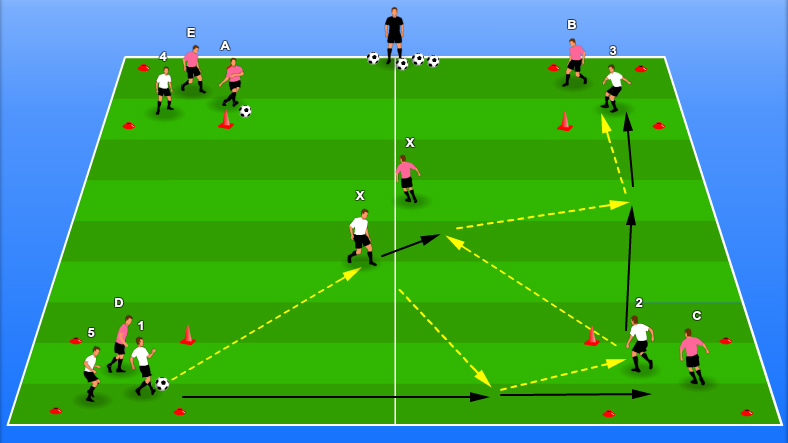Pass and Move Square 2
- Author: Ian Knapp
- Age Group: U10 to U17+
- Time: 15 - 20 minutes
Introduction:
This is a progression to the Pass and Move Square practice, introducing one or more central players to give the players more mental challenge, more realism in terms of angles and movement and a greater technical challenge in terms of passing and moving on the go. This is an exercise for older or more advanced players.
Setup:
- A large square (side dependent on age / ability - players need to be able to pass the length of one side of the square).
- 4 smaller squares marked off in the outside corners of the larger square.
- Split the players into 2 groups of 6, with different coloured bibs for each group. Each corner of the square has one player of each colour, but in 2 opposite corners, you add one extra player so one corner has 2 whites and one pink, with the opposite corner having 2 pinks and one white (see diagram below).
- One player from each team in the centre of the square.
- One ball per team (starts with one of the players in a corner where their team is doubled up)
- Coach with more footballs to the side.
Basic Rules:

- Each teams begins play from whichever corner has 2 of their players in. Using whites as an example above...
- Player 1 plays a pass to the middle player (player X) and then starts to run toward the next corner.
- Whilst on the move, they receive the ball back from player X, take a touch and pass the ball in to player 2, who is in the corner they are headed for.
- Player 1 continues their run, following their pass until they reach the corner.
- Player 2 then repeats the process, playing a pass to the central player (player X), moving on to the next corner, receiving the ball back and delivering a pass to player 3 whilst on the move.
- This pattern repeats, with every player using the central player to play a bounce pass whilst on the move to their next destination.
- Switch the central player periodically to give everyone a chance.
- The second team (pinks), do exactly the same thing, but heading in the opposite direction.
Progressions & Variations:
- If it is too difficult, create 2 squares and have each team working on a separate square, so they don't get in each other's way.
- Make the square smaller or larger, depending on whether you want to practice long or short range passing.
- Turn the square into a rectangle to allow both long and short range passing practice in the same exercise.
- If you have more or less players, double up in some other corners and have the players take turns being the active player.
- Introduce a central player to bounce the ball off (see this exercise for an example of this).
5 Key Coaching Points / Challenges:
- Can you receive the ball on your back foot, with your body shape such that you can see both the player passing to you and the player you are about to pass to?
- Weight, type and accuracy of pass. Where does the receiving player want the ball and with what power do they want it? Not behind them, not too high, too hard or too soft.
- Central player, can you constantly be on the move to be an option for the player about to pass the ball to you?
- Communication - verbal and pointing to show where you want the ball.
- Awareness - play with your head up - know where your team mates and the other team are at all times. If you don't do this, you will collide with people / balls will collide with each other.
Coaching Points (FA's 4 Corners):
| Technical | Psychological |
|---|
- Body shape - receive across your body onto your back foot to give yourself the best chance of playing the next pass quickly.
- Can your body shape allow you to see the player passing to you and the player you're about to pass to?
- Passing to the correct foot of the receiving player.
- Weight and type of pass
- First touch - take the ball where you want it to go so you can make the next pass.
- Play with your head up - know where your team mates / the other team are at all times.
- Central player - movement to be an option constantly.
|
- Communication (verbal and using body shape / pointing)
- Thinking ahead - decide what you're going to do next BEFORE the ball has arrived with you
- Decision making - what type of pass.
- Awareness - being mentally alert to pass and then move quickly on to the next corner.
- Awareness of where everyone is on the pitch (your team mates and the other team)
|
| Physical | Social |
|---|
- Speed of play (quick is usually better, but accuracy comes before speed)
- Body shape
- Agility to control and pass on the move.
|
- Working as a team
- Encouraging others and not being negative
- Communication
- Have fun!
|